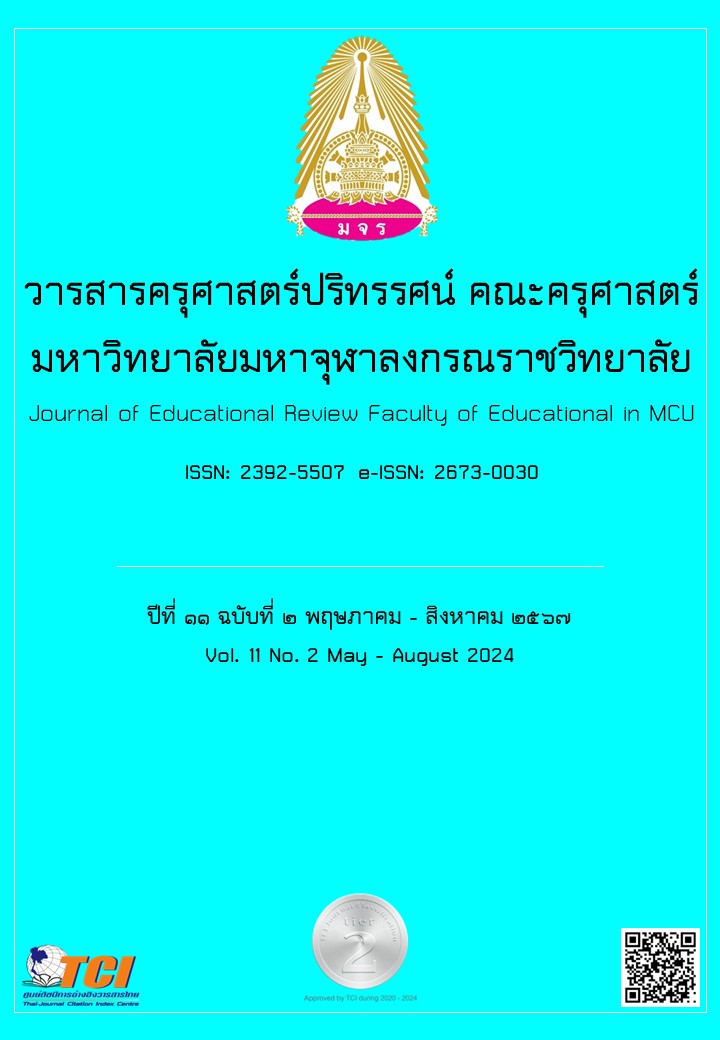รูปแบบการบริหารจัดการศูนย์ปฏิบัติธรรมตามหลักสัปปายะ 7 ในเขตการปกครองคณะสงฆ์ภาคตะวันออกเฉียงเหนือ
Main Article Content
บทคัดย่อ
บทความวิจัยนี้มีวัตถุประสงค์เพื่อ 1) ศึกษาสภาพการบริหารจัดการศูนย์ปฏิบัติธรรม 2) พัฒนารูปแบบการบริหารจัดการศูนย์ปฏิบัติธรรมตามหลักสัปปายะ 7 และ 3) ประเมินรูปแบบการบริหารจัดการศูนย์ปฏิบัติธรรมตามหลักสัปปายะ 7 เป็นการวิจัยแบบผสมผสานวิธี โดยการวิจัยเชิงปริมาณใช้แบบสอบถามกลุ่มตัวอย่างจำนวน 364 รูป/คน ส่วนการวิจัยเชิงคุณภาพสัมภาษณ์กลุ่มเป้าหมายและการจัดสนทนากลุ่ม เครื่องมือในการวิจัยคือแบบสอบถาม แบบสัมภาษณ์ และคู่มือการสนทนากลุ่ม การวิเคราะห์ข้อมูลการวิจัยด้วยการวิเคราะห์ด้วยค่าความถี่ ค่าร้อยละ ค่าเฉลี่ย ส่วนเบี่ยงเบนมาตรฐาน และการวิเคราะห์เนื้อหา ผลการวิจัยพบว่า 1) สภาพการบริหารจัดการศูนย์ปฏิบัติธรรมในเขตการปกครองคณะสงฆ์ภาคตะวันออกเฉียงเหนือ ในภาพรวมและรายด้านอยู่ในระดับมากทั้ง 5 ด้าน คือ การบริหารจัดการอาคารสถานที่ การบริหารจัดการอำนวยการและสื่อสาร การบริหารจัดการองค์กร การบริหารจัดการควบคุมดูแลบริการ การบริหารจัดงานบุคคล ตามลำดับ 2) รูปแบบการบริหารจัดการศูนย์ปฏิบัติธรรมตามหลักสัปปายะ 7 ประกอบด้วย 5 องค์ประกอบ คือ (1) หลักการ แนวคิด (2) วัตถุประสงค์ (3) เนื้อหา (4) บูรณาการด้วยหลักสัปปายะ 7 (5) ผลลัพธ์ที่คาดหวัง และ 3) ผลการประเมินรูปแบบการบริหารจัดการศูนย์ปฏิบัติธรรมตามหลักสัปปายะ 7 ในภาพรวมอยู่ในระดับมาก สรุปองค์ความรู้จากการวิจัยคือ “PS”
Article Details

อนุญาตภายใต้เงื่อนไข Creative Commons Attribution-NonCommercial-NoDerivatives 4.0 International License.
ทัศนะและความคิดเห็นที่ปรากฏในบทความในวารสารฉบับนี้ถือเป็นความรับผิดชอบของผู้เขียนบทความนั้นเพียงผู้เดียว และไม่ถือเป็นทัศนะและความรับผิดชอบของกองบรรณาธิการ
กองบรรณาธิการขอสงวนสิทธิ์ในการคัดเลือกบทความลงตีพิมพ์และจะแจ้งให้เจ้าของบทความทราบหลังจากผู้ประเมินบทความตรวจอ่านบทความแล้ว
ต้นฉบับที่ได้รับการตีพิมพ์ในวารสารครุศาสตร์ปริทรรศน์ คณะครุศาสตร์ มหาวิทยาลัยมหาจุฬาลงกรณราชวิทยาลัย ถือเป็นกรรมสิทธิ์ของคณะครุศาสตร์ มหาวิทยาลัยมหาจุฬาลงกรณราชวิทยาลัย ห้ามนำข้อความทั้งหมดหรือบางส่วนไปพิมพ์ซ้ำ เว้นเสียแต่ว่าจะได้รับอนุญาตจากมหาวิทยาลัยฯ เป็นลายลักษณ์อักษร
เอกสารอ้างอิง
กระทรวงมหาดไทย. (2564). จำนวนวัดในภาคตะวันออกเฉียงเหนือ. แหล่งที่มา https://edw-opendata.moi.go.th/dataset/page/602f224159e311fb6c2398c6931fc0c50a6f1e0dbf4c9 สืบค้นเมื่อ 22 ส.ค. 2565.
ปริญญ์ ทนันชัยบุตร. (2553). การพัฒนารูปแบบการจัดการเรียนรู้ทัศนศิลป์เพื่อพัฒนาความคิดสร้างสรรค์. วิทยานิพนธ์ศึกษาศาสตรดุษฎีบัณฑิต. มหาวิทยาลัยขอนแก่น.
พระครูวัฒนสุตานุกูล. (2557). กระบวนการพัฒนาวัดให้เป็นแหล่งเรียนรู้ของคณะสงฆ์ไทย. วิทยานิพนธ์พุทธศาสตรดุษฎีบัณฑิต. มหาวิทยาลัยมหาจุฬาลงกรณราชวิทยาลัย.
พระครูวิโรจน์เขมคุณ (ไพโรจน์ เขมจิตฺโต). (2563). รูปแบบการบริหารสำนักปฏิบัติธรรมตามหลักสัปปายะ 4 ในจังหวัดสิงห์บุรี. วารสารสังคมศาสตร์และมานุษยวิทยาเชิงพุทธ. 5(5). 13.
พระมหาขวัญ ถิรมโน. (2553). วัดอรุณราชวราราม: บทบาทการพัฒนาทางเศรษฐกิจ สังคม และวัฒนธรรมของวัดที่ส่งผลต่อศรัทธาของประชาชน. ดุษฎีนิพนธ์ปรัชญาดุษฎีบัณฑิต. มหาวิทยาลัยมหาสารคาม.
วิวัฒน์ชัย บุญยภักดิ์. (2531). วัด: จำเป็นอย่างไรจะต้องมีคู่มือพัฒนา. จุลสารการท่องเที่ยว. 7 (1). 74-76.
ศรินทิพย์ สถีรศิลปิน และคณะ. (2548). รูปแบบการจัดการศึกษาและการเผยแผ่ศาสนธรรมของวัดในพระพุทธศาสนากรณีศึกษาวัดราชโอรสารามเขตจอมทองกรุงเทพมหานคร. รายงานการวิจัย.กรุงเทพมหานคร: ภาพพิมพ์.
Apapirom, A. (1978). Social and Thai Culture. Bangkok: Bumrungnukulkit Printing.
Phramaha Suthit Aphakaro. (2011). The Model and Learning Network of Buddhist Temples Tourism in Thailand. Bangkok: The Thailand Research Fund.
Pintamul, P. (2017). Management Corporate Social Responsibility According to the Buddhist Monks of Thailand for Community and Society. Journal of Arts Management. 1(2). 119-128.


